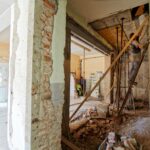An FHA 203(k) loan is a mortgage product backed by the Federal Housing Administration that you can use to purchase a home and pay for renovations. It lumps the purchase price and home improvement costs into a single mortgage, and you make one monthly payment instead of two.
What is an FHA 203k Loan?
These rehab loans are geared towards prospective homeowners looking to purchase a fixer-upper and make upgrades without paying out of pocket. If you already own your home, you can also use an FHA 203(k) loan to refinance your existing mortgage and fund much-needed renovations.
You can choose from the following FHA203(k) loan options:
- Standard 203(k) Loan: This loan product can be used to pay for renovations and structural repairs that cost more than $5,000 and $35,000, respectively. Before the project starts, the homeowner is required to bring a consultant from the Department of Housing and Urban Development (HUD) on board to monitor the project.
- Streamline 203(k) Loan: This loan can be used to cover renovations of up to $35,000, and the funds cannot be used to pay for structural repairs.
Be mindful that these loans can be used for various home improvement projects. Still, luxury upgrades, like outdoor fireplaces, BBQ pits, satellite dishes, hot tubs, and swimming pools, are not allowable expenses.
How Does an FHA 203k Loan Work?
FHA 203(k) loans are available as 15- or 30- year fixed-rate or adjustable-rate mortgages through FHA-approved lenders. The qualification criteria for these government-backed products are more lenient than what you’ll find with most renovation home loans. Plus, you’re allowed to use a portion of the loan proceeds to cover labor and materials associated with home improvement projects.
When the loan closes, you’ll have 30 days to start the project. Furthermore, all work must be finished within six months, and payments are remitted to the contractor(s) from an escrow account established at closing.
Do You Qualify for an FHA 203k Loan?
Review the eligibility requirements before deciding if an FHA 203(k) loan could work for you.
Credit Score
You may be eligible for a loan with a score as low as 500. However, most lenders prefer borrowers with a score of 580 or better.
Down Payments
The minimum down payment is 3.5 percent if you have a score of at least 580. But you’ll need 10 percent down if your score is between 500 and 579.
Debt and Income
There are two debt-to-income (DTI) ratios to consider:
- Front-end DTI: It is the percentage of your gross monthly income spent on housing costs and should not exceed 31 percent. So, if your gross earnings are $7,000 per month, your monthly mortgage payment should be no more than $2,170.
- Back-end DTI: It is the percentage of your gross monthly income spent on minimum monthly debt payments, including your mortgage. Lenders typically want to see this number at or below 43 percent. For example, if your monthly gross earnings are $6,500, the total amount spent on your outstanding debt obligations and mortgage should not exceed $2,795.
If you have good or excellent credit, the lender could approve your application with a higher DTI.
Loan Amounts
The FHA loan limit is $420,680 in most areas. However, it goes up to $970,800 in cities with a higher cost of living.
Residency and Citizenship Status
These loans are offered to U.S. citizens and non-U.S. citizens who are permanent legal residents with valid Social Security numbers who can provide proof of eligibility to work in the U.S.
Occupancy Requirements
You must be purchasing or refinancing your primary residence to qualify for an FHA 203(k) loan. Second homes and investment properties are ineligible.
Advantages and Disadvantages of FHA 203k Loans
FHA 203(k) loans have their share of benefits and drawbacks to consider.
Pros of FHA 203k Loans
- You could get approved for a loan with a competitive interest rate, even if you have less-than-perfect credit.
- The minimum down payment requirement is relatively low.
- You’ll streamline the repayment process with a single loan product.
- You can cover temporary housing costs during the renovation.
Cons of FHA 203k Loans
- You’ll pay a mortgage insurance premium upfront, along with monthly mortgage insurance premiums over the life of the loan.
- You’re prohibited from using these loan products to buy and upgrade investment properties.
- The timeline for renovations is limited to six months, and you may have to hire a HUD consultant to oversee the project.
- There are restrictions on the types of home improvements you can complete.







